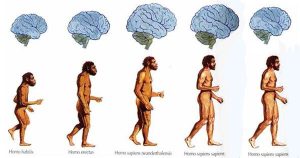Small brains can cause intelligence to decline, but how does Homo Sapiens still rule the Earth?
The average size of the human brain is shrinking , and the process began tens of thousands of years ago. It’s a fact well known to anthropologists: Skull measurements show that over the past 40,000 years, the average volume of Homo sapiens brains has decreased by about 10%. This decline contrasts with the trend of skull enlargement that occurred during human evolution millions of years earlier.
Please clarify to ease your anxiety: Although you may have a smaller skull than your Stone Age ancestors, the human brain today is still three times the size of the normal brain size of a primate with the same body weight as ours .

The average size of the human brain is dwindling. (Photo: Ancient Origins)
According to Discover Magazine, because the brain doesn’t last long after death, anthropologists have had to deduce information about our neural evolution from fossil skulls. The unit that represents the size and sophistication of the brain chosen by scientists is the endocranial volume , the space inside the skull. This value is not exceptional for the earliest hominid species present more than 4 million years ago. The oldest skulls believed to represent human ancestors such as Sahelanthropus, Ardipithecus had an intracranial volume of about 350 mm, comparable to that of chimpanzees today.
But after this period, brain enlargement became a prominent feature of our lineage. From about 4 million to about 2 million years ago, the Australopith species (which lived in Africa in the late Pliocene early Pleistocene) had a skull capacity of nearly 500 ml. A million years ago, the brains of some Homo erectus species (the first humans to walk upright) exceeded 1 liter (1000 ml). And average skull capacity reached nearly 1.5 liters around 130,000 years ago in both Neanderthals (with specimens ranging from 1,172 to 1,740 ml) and Homo sapiens (1,090 to 1,175 ml).
It should also be noted that, since the time of Homo erectus, our stature has not changed significantly, so much of this brain development occurred independently of the development of body size.

The fossilized skull of the female primate Australopithecus afarensis, briefly named Lucy, is in the museum (Image: Shutterstock)
Based on measurements from 122 populations, the scientists found that the intracranial capacity of modern adults ranges from 900 to 2,100 milliliters, with a global average of 1,349 milliliters, smaller than those found in other populations. Our ancestors lived in the Stone Age. However, we cannot draw meaningful conclusions from the global averages for this species as a whole, in part because the method of measuring skulls varies across data sets.
More convincing evidence for the reduction in skull size could come from studies using the same measurement technique, with specimens from thousands of skulls of primates that once inhabited an area. certain for thousands of years.
For example, a study published in the scientific journal Human Biology in 1988 analyzing more than 12,000 Homo sapiens skulls from Europe and North Africa found that, over the past 10,000 years, skull volume has decreased by approximately 10% (157 ml) in men and 17% (261 ml) in women. Skulls from other parts of the planet such as sub-Saharan Africa, East Asia and Australia also experienced similar reductions.
The most recent geological epoch is the Holocene of the Neogene, Quaternary, which began when the Pleistocene ended 11,700 years ago. The Holocene is considered a thaw in the current glacial period, characterized by a stable, comfortable climate. Since discovering the human skull’s tendency to shrink in the late 1980s, researchers have come up with several possible explanations.
Some say this drop is due to a slight decrease in body size and strength, which is related to the warmer conditions of the Holocene. Large body size increases the individual’s chances of survival during the Ice Age, but then becomes detrimental as the climate warms. However, anthropologist John Hawks countered this idea by pointing out that the observed brain decline was too great to be explained by smaller body size.
Other researchers point to the fact that the brain is an energy-intensive organ . Although the modern brain is only 2% of the human body weight, it consumes almost a quarter of the energy input. One proposal is that humans have been able to eliminate a little brain capacity by inventing many external ways of storing information such as cave wall art, writing, digital media.

A cave in Bulgaria has carved images of ancient people 8,000 years ago. (Image: Wikimedia).
But perhaps the most convincing theory is that Homo sapiens underwent self-domestication , a proposition rooted in our understanding of animal domestication. Sheep, dogs, and domesticated species differ from their wild ancestors in a number of physical and behavioral traits. These traits include: tameness, less shyness, youthful appearance in adulthood, and smaller brains.
Research has shown that these traits—collectively known as domestication syndromes—are influenced by the same hormones and genes . Humans have selectively bred animals with these desirable traits, creating livestock and livestock. The self-domestication hypothesis, or what anthropologist Brian Hare calls “survival of the friendliest,” suggests we’ve done this to ourselves, too.
The main idea of this hypothesis is that, in Stone Age societies, individuals who lived in a community and cooperated well with the surrounding factors were more likely to survive and maintain the species than those who lived in a community. war and aggression. Both pro- or antisocial tendencies are influenced by hormones that regulate genes, and these hormones also influence physical characteristics such as body size and brain.
Over time, “survival of the friendliest” produced a human species with a lighter body and brain on average. So despite a reduction in skull size – and possibly a decline in intelligence as well – the capacity for human cooperation has increased, fostering greater collective intelligence. A few socially smaller brains are certainly more cunning than a lonely large head.

